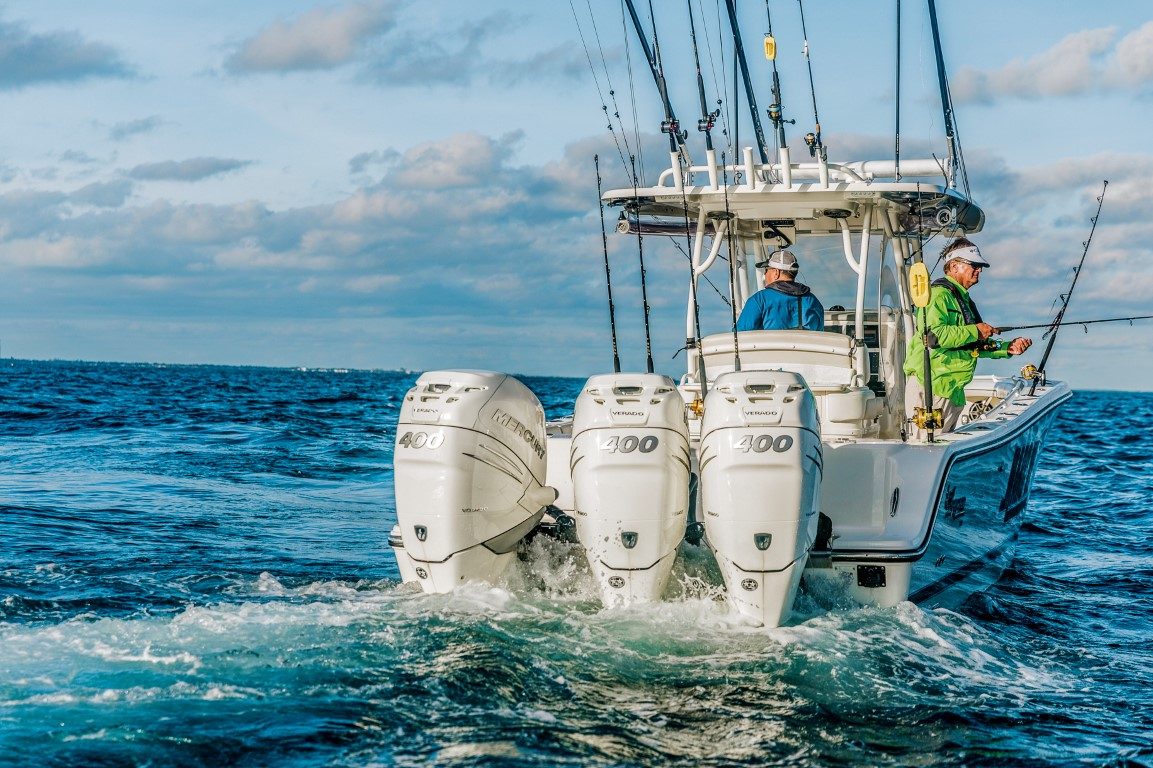

Today’s outboard engines incorporate some of the most advanced engineering on the planet, writes Craig Ritchie.
But the process of building them is even more high-tech, as Boating New Zealand discovers on an exclusive, behind-the-scenes tour of Mercury Marine’s state-of-the-art engine plant.
While most of us already know that modern fuel-efficient, low-emission outboards are technological marvels, few have ever considered what goes into building one of them. I mean, think about it. How do you get from a block of raw aluminium to a state-of-the-art outboard?
It’s an amazing and complex process that goes beyond high-tech, as we discovered when we took a peek inside Mercury’s main outboard production plant in Fond du Lac, Wisconsin. Fond du Lac is more than just the company’s global headquarters. It’s also the primary manufacturing complex where it builds all outboards of 75hp and up (engines of 40, 50 and 60hp are built in Suzhou, China, while those of 30hp and less are made in Japan as part of a joint venture with Tohatsu).
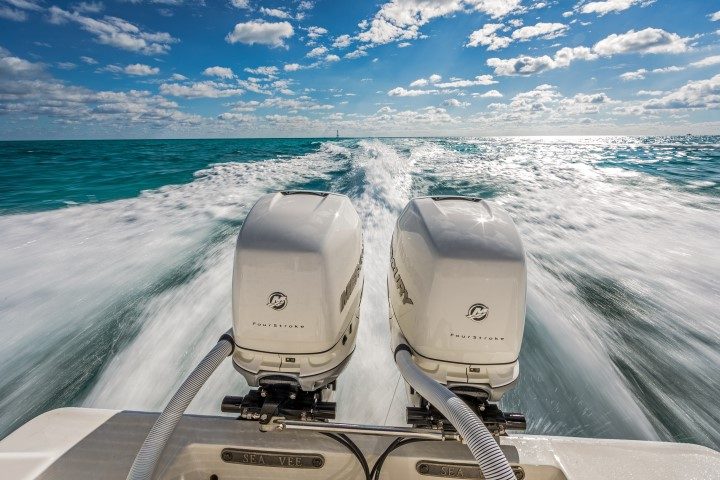
FDL, as it’s called, is where Mercury builds the V6 and V8 four-strokes and Verados that represent the heart of the company’s lineup and its most advanced engines yet. Gaining access to the plant isn’t easy – especially for journos who show up with a camera in hand. Even after weeks of making the requisite arrangements and lining up the necessary permissions, it was still a bit of an ordeal getting through the security gates with a bag full of Nikons. But, entirely worthwhile.
Right from the start, it’s important to note that the term ‘plant’ isn’t entirely accurate because the 34-hectare complex comprises 15 separate buildings representing nearly 251,000m2 of manufacturing space. Home to more than 3,300 employees – the most in Mercury’s 80-year history – it’s a dynamic place that’s still growing.
Our visit happened to coincide with the ribbon-cutting on a brand-new, US$9 million expansion to Mercury’s die-casting plant, and at one point our tour had to divert around a construction crew working on a $17 million expansion of the existing propeller plant.
Just last year Mercury spent $80 million on a new V6/V8 assembly line in its main assembly building, as well as an expansion of its Noise, Vibration and Harshness (NVH) engine testing facility. All told, over the past decade Mercury has invested a whopping $1.1 billion in its Fond du Lac facility and it continues to invest in new equipment and people.
CASTING CALL
Our tour began where the engines do, in a nondescript building known as Plant 17 – home to Mercury’s aluminium foundry and casting operations. As you don your protective safety gear and prepare to step inside, you’re reminded that you’re about to enter an environment that’s loaded with liquid metal.
Mercury enjoys a tremendous safety record and it’s one they take very seriously, so those rare VIP visitors are kept under extremely close supervision and constantly reminded to never make a move without first looking 360°.

One of the first sights – as you enter the foundry – is the raw material stores, where huge slabs of aluminium are received, sorted and prepared to be melted down and mixed with other metals to produce Mercury’s proprietary alloy. This low-copper, corrosion-resistant alloy is used to cast thousands of different parts, representing up to 80% of the engines’ components.
Mercury uses a variety of different casting processes in creating engine parts, and the specific method used depends on the type of part being made. Die-casting is used to create large, complex elements like engine blocks, driveshafts and gearcases – big, bulky stuff that can only be cast with equally big equipment.
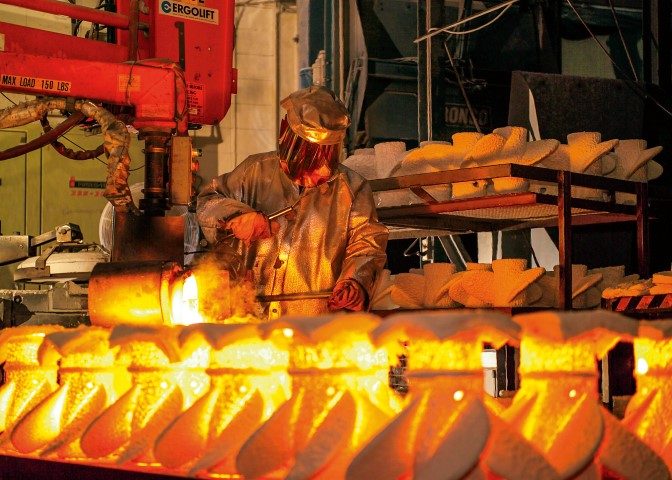
That includes a pair of 4,100-tonne die-cast machines, among the largest of their kind in North America. Even the tooling seems super-sized here. The V8 engine block tool, for example, weighs in excess of 45,000kg and measures nearly five metres across.
Pressurised lost foam casting is another specialised process used to create sophisticated components like cylinder heads. Styrofoam patterns – each stamped with a unique serial number – are used in high-pressure sand moulds to create these intricate and complicated parts. The patterns are dipped in a special non-stick coating then topped with a fill funnel, before being lowered into a heavy, cast iron vat.
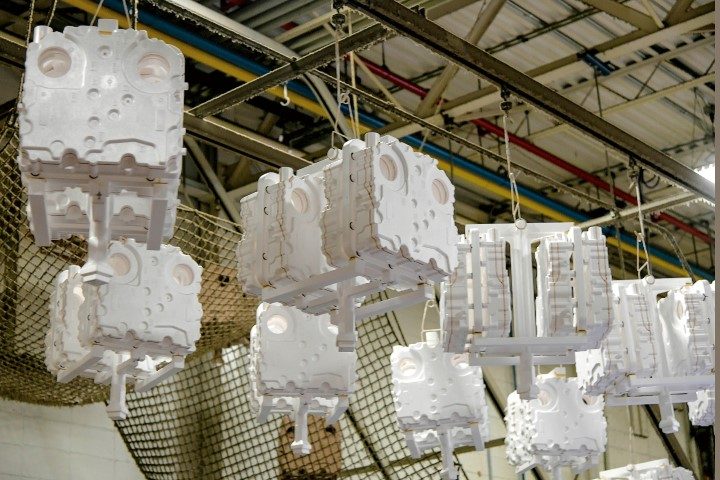
About a tonne of super-fine synthetic sand (called ‘mullet’) is then poured into the vat, completely surrounding the Styrofoam form and filling all the nooks and crannies. Screeching-hot liquid alloy is poured in through the fill funnel, instantly vaporising the Styrofoam on contact and assuming its shape, replacing it in the sand mould – hence the name ‘lost foam.’
Some 10 minutes after the molten alloy is fully set, the sand is drained from the vat, the new part is removed and dipped in a water bath to ensure even cooling. The sand’s then re-used for another casting. It sounds simple, but lost foam casting is tricky to master. Too much sand and you crush the Styrofoam pattern. Not enough, and you don’t get a clean casting.
CUTTING CREW
Newly-cast parts are given a thorough cleaning and inspection before they move next door into what’s known as Plant 4, where milling and machining transform the raw castings into precision components.
The process begins with a more detailed examination that includes some preliminary de-burring, measuring and testing. If a part doesn’t meet specifications perfectly, it’s pulled out of the queue and melted down for use in another part. Mercury recycles a surprising volume of material – mainly in the form of aluminium shavings as parts are machined, but occasionally including entire components that simply didn’t pass its rigorous quality control standards.
Much of the machining work takes place in closed environments where computer-controlled robots use advanced tools to machine parts to ultra-precise tolerances. Mercury has invested heavily in the technology, and the Fond du Lac complex includes 29 Mazak HMC precision CNC machines – more in one place than anywhere else in North America, including all of the major auto makers.
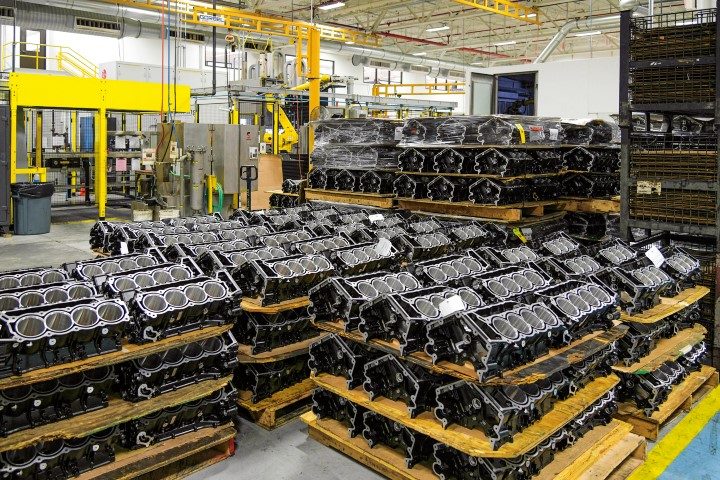
The commitment to automation delivers greater precision and consistency from one part to the next. The robots are smart – they even account for wear and tear on the cutting tools, adjusting in real time as the blades dull with use. When it’s almost time for a new tool, the robot signals the floor supervisor who then makes the necessary changes. This is particularly beneficial in labour-intensive operations such as cutting gears, where the precision machining of super-hard materials is absolutely critical.
More importantly, the use of robots has greatly contributed to improved worker safety. Throughout the Mercury plant, posters and clocks marking accident-free hours speak to the company’s commitment to improving the working conditions of its employees. Robots performing their work within enclosed environments greatly reduce noise levels and improve working conditions for all.

Once components pass further quality control checks, they move to what’s known as Plant 15 for an appointment with Mercury’s 4,552m² EDP facility. EDP stands for Electro-Deposition Paint, and it is applied to approximately 95% of the engine’s parts as a key element in anti-corrosion technology.
What’s immediately clear is that the EDP facility isn’t any ordinary paint shop. To the contrary, the process is more reminiscent of electroplating, using an electrically-charged paint which is applied to oppositely-charged parts so it doesn’t just stick, it actually bonds on a molecular level.
Exterior-facing parts are further treated with an electrostatically-charged powder paint for further corrosion protection, while still other elements – such as the internal passages in larger horsepower engines – are coated with Mercury’s proprietary SaltShield chemical treatment. This is one part of the tour where details became vague, since Mercury’s approach to corrosion protection remains a closely guarded trade secret.
COME TOGETHER
By the time they emerge from the EDP facility, the completed engine parts have come a long way from that original slab of raw aluminium. All that remains now is assembly. If the engineering side of the complex represents the high tech in building outboards, assembly is where the magic happens.
The EDP only marks the beginning of Mercury’s Plant 15, the largest building in the enormous complex. As you move into the main assembly area, still more robots perform final quality control tests and take precision measurements, with any suspect parts immediately pulled from the queue for recycling.
We’re talking about tolerances within 40-millionths of an inch, or about 100 times thinner than a human hair. It’s not just Mercury’s own parts – this is also the point where components sourced from outside suppliers are checked and verified.
As the parts move to the engine assembly lines, a different type of robot emerges – one that’s self-propelled and self-driving. These devices replace the traditional conveyor belt assembly line, moving the engine from station to station by following a magnetic track in the factory floor.
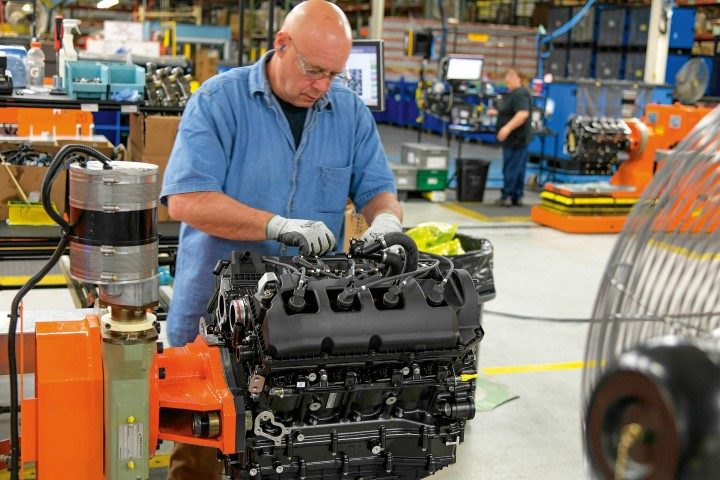
This approach allows employees to easily adjust the engine’s height and angle so they can work comfortably, without having to stretch or kneel. It’s a smart idea that not only reduces employee fatigue and the incidence of repetitive stress injuries, it also makes the work far easier for employees who otherwise might not have the strength to muscle heavy components into place. As a result, a substantial proportion of Mercury’s assembly workers are now female – quite the opposite of what one might expect to see in an engine factory.
Because multiple outboard models can come down the assembly line at once, employees scan a bar code on the engine to reveal which specific parts are to be installed. Simultaneously, corresponding ‘parts bins’ illuminate to identify the correct components to be used. Tool settings, such as torque levels on impact wrenches, are set automatically.
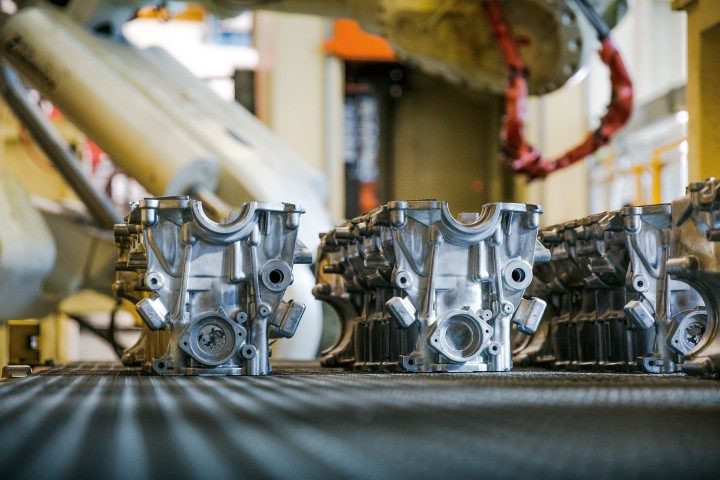
Once the engine powerhead is assembled, it’s given yet another quality control test – turning it over at about 600rpm to ensure internal pressures, sound levels and all moving parts meet specific targets.
After passing the cold spin test, the powerhead is joined to its corresponding main frame and midsection. Electrical components, superchargers, bolt-on elements like digital throttle-and-shift and other bits are then added, along with the gearcase to complete the engine. It’s then filled with oil and run in a test tank to confirm it meets all design specifications, including power output, noise levels, fluid pressures and operating temperatures.
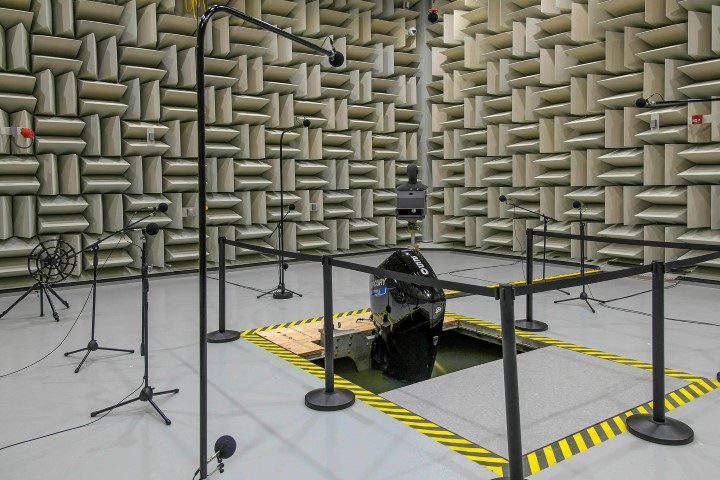
At this stage, all that remains is to install the cowling. The completed outboard is crated for shipping to a dealership or a boat builder, and on to a buyer.
The journey from a block of solid aluminium to a state-of-the-art outboard involves a lot of different steps, some extraordinary engineering, and perhaps even a touch of magic. But Mercury’s investments in technology and continuous improvement are paying dividends as the company gains ground on engine back-orders amid ever-growing demand.




